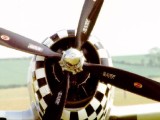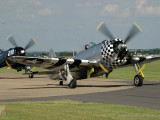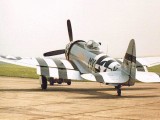Republic P-47D Thunderbolt “No Guts, No Glory“
The largest and heaviest (it weighs in at seven tons and is heavier than even a Bristol Blenheim or a Bristol Beaufighter) single-seater piston-engined fighter in history, and the most numerous American fighter ever produced, the <i>Jug</i> was a hugely successful high altitude escort and a formidable ground attack aircraft.
The 15,000+ Thunderbolts produced and used in World War II, saw service in every theatre of operations except Alaska. By the end of 1944 it equipped 31 USAAF groups and served with many other Allied Air Forces, including the RAF who took 830 machines.
It could take almost as much damage as it could hand out, quickly establishing a reputation for allowing pilots to walk away from all but the most horrendous crashes and absorbing extraordinary amounts of battle damage.
It was phased out of American service soon after the end of the war and was dropped from the US inventory in 1953, but was absorbed into many lesser Air Forces around the world, last seeing combat service in the Guatemalan Revolution of 1953.
Its adoption in Latin America led, eventually, to its survival in relatively large numbers, being openly stored in a number of areas, allowing recovery of both airframes and associated spares. To produce a Jug in 1945 would have cost $85,000 – a sum which today wouldn’t even get you a major overhaul.
Our Thunderbolt was built in 1945 at Republic’s Evansville factory in Indiana. Serialled 45-49192 the aircraft was built originally as a P-47D-40-RA. Detail of its service with the USAAF is not known, although it did serve with the Air Training Command during the last few months of the War, and was eventually stored at Tinker AFB in Oklahoma with the Air Material Command.
It was restored to full operational status at Hensley Field in Texas in 1952, after the Rio Pact had been signed by the USA, and was assigned to the Military Assistance Program in September of that year.
In 1953 it formed part of a group of P47’s which found their way to the Peruvian Air Force, who paid the princely sum of one dollar for each of the 25 aircraft it took from the USA. In the hands of the grateful Peruvians it gave good service until 1967, initially as a front line fighter and then as a fighter trainer, and having had an all over silver paint scheme applied. Six Thunderbolts, number 119 among them, were stored in the open at the Piura Air Base until 1969 when, after long and difficult negotiations, aviation historian and enthusiast Ed Jurist was able to recover them, with over 45 tons of spares, to the USA.
Even the sea journey was far from simple, with the ship losing contact with the new owner for several days, long enough for Jurist to believe that his precious cargo had foundered in a hurricane which had been encountered after they had left the Panama Canal, when in fact the Captain had put into a small harbor in the Gulf of Mexico. The ship reached Texas on the 5th of September, 1969. Two days after docking, the Confederate Air Force had all six aircraft firmly locked away in their new Fighter Wing hangar at Harlingen.
Each of the aircraft was given a new FAA registration, the TFC machine being allocated N47DD. The CAF had N47DA (Peruvian 114) in the air on the 26th August 1971, after four months of reassembly.
The 2nd of December the same year saw N47DB airborne again and by February 1974 all six were airworthy and being operated by the CAF from Harlingen, under their adoption; scheme. N47DD wore the colours of a 12th Air Force machine, from the 86th Fighter Group, 527th Fighter Squadron, which was based in Italy during the war.
In April of 1975, Ed Jurist sold all his aircraft holdings to restaurateur David Tallichet. The deal included a Mosquito, a Mustang, a Spitfire and the six Jugs. Each of the aircraft were flown to Barstow-Dagget Airport, by Tallichet himself, where they were stored in the open for some time.The collection was effectively split up with the formation of Tallichets Yesterdays Air Force with wings of the organization being set up around the country.
N47DD was delivered to the Kansas Wing of the YAF, at Forbes Field in Topeka, in February of 1977. The silver paint applied by the CAF had worn and the Peruvian markings were showing through and the aircraft was looking rather disheveled. The airframe was stripped to bare metal by a team of volunteers, and the scheme and markings of Col David Schilling from the 56th FG, 62nd FS, were applied with the aircraft forming the star exhibit in the new YAF museum at Forbes field, which opened on July 2nd 1977. Two and a half years later, in January 1980, N47DD was sold by Tallichet to a B-52 pilot from Texas. Robin Collard had just restored and subsequently sold a P-51 Stump Jumper and was looking for a new challenge.
After some preparation, N47DD left Kansas on the 8th February 1980 bound for Del Rio, Texas, although it made a stop-over in Tulsa, Oklahoma, that night. The following morning, the engine refused to develop sufficient power to take off normally, and then failed completely leaving the ferry pilot no option but to force land in a field about half a mile from the end of the runway. Maintaining the Jugs safety record to the full, the pilot suffered only minor injuries. The Thunderbolt was badly damaged.
A helicopter form the nearby Army Reserve transferred the remains of the aeroplane from the field and on to a truck a few days after the accident, and N47DD continued its journey to Del Rio, in a less happy state than originally intended. Shortly after, Collard was able to purchase an unused fuselage from Wayne Williams, which has passed through a number of owners, including David Tallichets YAK collection.
With a number of components which came his way, Robin Collard intended to restore the aircraft to flying condition, although in June of 1980 all the parts, the two fuselages and the complete project were sold to Jon Ward.Everything was then shipped out to Truckee-Tahoe airport in Nevada, where the massive rebuild job was started. Four years later, the project was sold on again, this time to Ward’s friend, Jim Kirby who, in turn, parted with it, to the benefit of The Fighter Collection, in late 1984. The aircraft was about 70% complete at this stage.
The aircraft was sent to Steve Hinton’s Fighter Rebuilders in Chino, California. Fighter Rebuilders had just completed a P-47G-15 for the Planes of Fame Museum at the time. With an overhauled P& W 2800 engine installed, and the metal work, systems fit and testing completed, in August 1985 the aircraft flew again for the first time since the crash of February 1980. It appeared at the 1985 Gathering of Warbirds at Medera, CA, in the hands of Steve Hinton himself.
It was disassembled for shipping to the UK in October the same year and arrived at Duxford on the 22nd of January 1986, being readied for the 1986 airshow season by the TFC engineers. After air tests the Thunderbolt, sporting its red cowling and tail, first appeared in Europe at the La Ferte Alais show in May 1986.
After completion of the season, a new paint scheme was applied. Sprayed silver overall, D-Day invasion markings were added and the black-and-white chequered cowling of the 78th Fighter Group, which had been based at Duxford during the period 1943 to 1945.This was a far from simple task as the cowls cover a huge area, and the chequers have to be exact. The serial no 226671 and codes MX-X were chosen, depicting the aircraft flown by Lt Col Ben Mayo, CO of the 82nd Fighter Squadron, 78th Fighter Group.
Lt Col Mayo’s personal markings were faithfully reproduced on the aircraft, a task eased following contact with Mayo’s Crew Chief Jim Tudor. Jim was able to supply details, from photos and memory, of the P-47 flown by Mayo making application of the No Guts, No Glory! legend, as well as the other markings and stencils, totally authentic. Jim also forwarded a cutting from the Air Force Magazine which paid tribute to the passing of Ben Isbel Mayo on January 23rd 1983, aged 63 years.<
The Thunderbolt has been seen all over Europe as well as the UK, attending shows as far apart as Sweden, Switzerland and France.
It has also taken part in film work, screaming through the valleys of Austria for the BBC dramatisation of Dennis Potter’s Christobel. Enormously popular with airshow crowds and American visitors, the aircraft provides a real link with Duxford’s own history and offers a tribute to the many aircraft, and their pilots, who flew from East Anglia between 1943 and 1945.
Gallery:




